Analysis of Democratic and Autocratic Nurse Leadership Styles
VerifiedAdded on 2022/09/15
|6
|1032
|26
Essay
AI Summary
This essay explores the contrasting leadership styles of democratic and autocratic leaders in the nursing profession. It begins by highlighting the importance of effective leadership in healthcare, emphasizing situational leadership and its impact on staff morale and patient outcomes. The paper then delves into the characteristics of democratic leaders, who encourage participation and collaboration, and autocratic leaders, who maintain strict control. It examines the advantages and disadvantages of each style, considering factors like decision-making speed, employee satisfaction, and the suitability of each style for different situations. The essay also identifies the environments where each leadership style is most effective, such as the level of team member experience and the need for quick decision-making. The conclusion underscores the importance of nurse leaders understanding the environment and choosing the appropriate leadership style for optimal results.
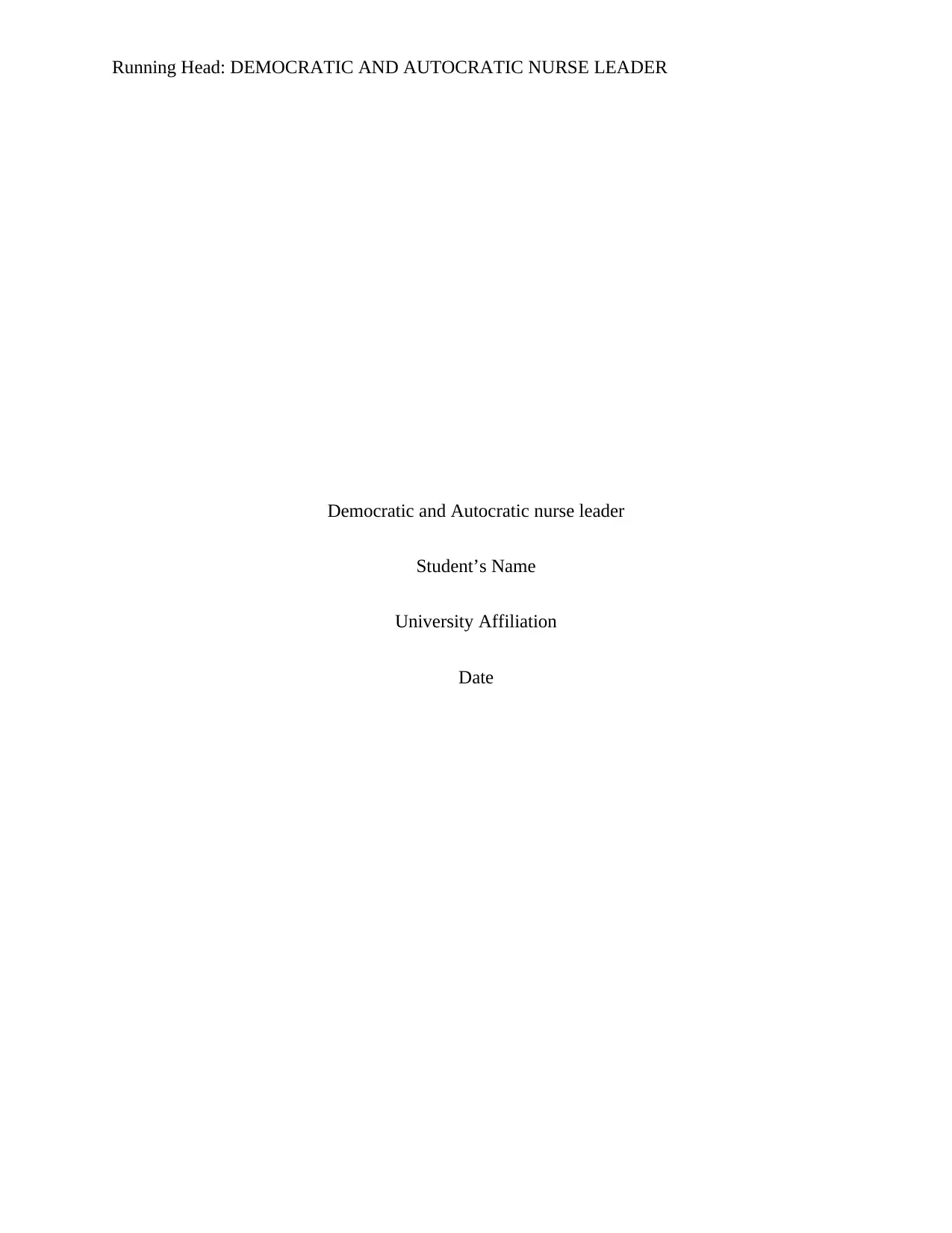
Running Head: DEMOCRATIC AND AUTOCRATIC NURSE LEADER
Democratic and Autocratic nurse leader
Student’s Name
University Affiliation
Date
Democratic and Autocratic nurse leader
Student’s Name
University Affiliation
Date
Paraphrase This Document
Need a fresh take? Get an instant paraphrase of this document with our AI Paraphraser
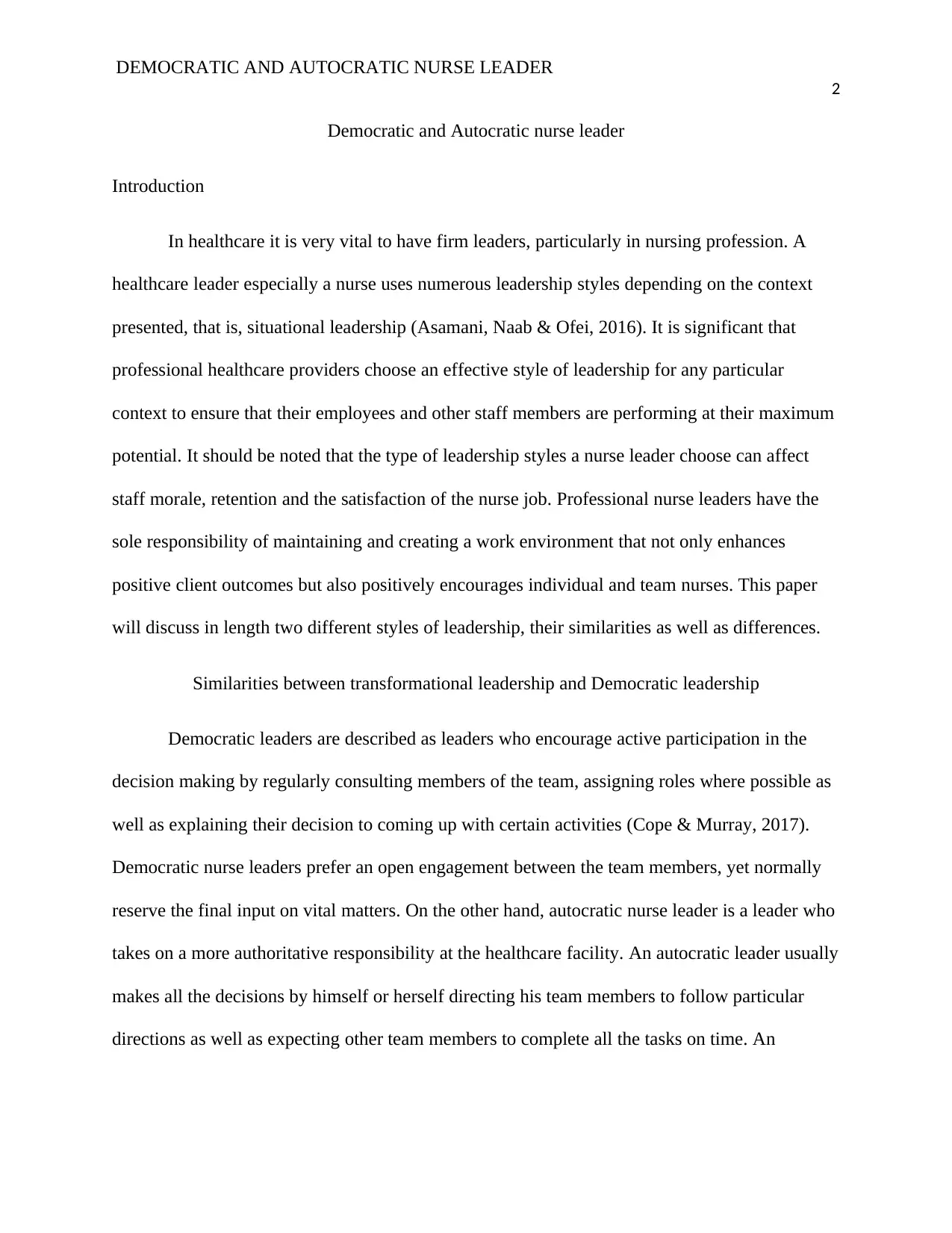
DEMOCRATIC AND AUTOCRATIC NURSE LEADER
2
Democratic and Autocratic nurse leader
Introduction
In healthcare it is very vital to have firm leaders, particularly in nursing profession. A
healthcare leader especially a nurse uses numerous leadership styles depending on the context
presented, that is, situational leadership (Asamani, Naab & Ofei, 2016). It is significant that
professional healthcare providers choose an effective style of leadership for any particular
context to ensure that their employees and other staff members are performing at their maximum
potential. It should be noted that the type of leadership styles a nurse leader choose can affect
staff morale, retention and the satisfaction of the nurse job. Professional nurse leaders have the
sole responsibility of maintaining and creating a work environment that not only enhances
positive client outcomes but also positively encourages individual and team nurses. This paper
will discuss in length two different styles of leadership, their similarities as well as differences.
Similarities between transformational leadership and Democratic leadership
Democratic leaders are described as leaders who encourage active participation in the
decision making by regularly consulting members of the team, assigning roles where possible as
well as explaining their decision to coming up with certain activities (Cope & Murray, 2017).
Democratic nurse leaders prefer an open engagement between the team members, yet normally
reserve the final input on vital matters. On the other hand, autocratic nurse leader is a leader who
takes on a more authoritative responsibility at the healthcare facility. An autocratic leader usually
makes all the decisions by himself or herself directing his team members to follow particular
directions as well as expecting other team members to complete all the tasks on time. An
2
Democratic and Autocratic nurse leader
Introduction
In healthcare it is very vital to have firm leaders, particularly in nursing profession. A
healthcare leader especially a nurse uses numerous leadership styles depending on the context
presented, that is, situational leadership (Asamani, Naab & Ofei, 2016). It is significant that
professional healthcare providers choose an effective style of leadership for any particular
context to ensure that their employees and other staff members are performing at their maximum
potential. It should be noted that the type of leadership styles a nurse leader choose can affect
staff morale, retention and the satisfaction of the nurse job. Professional nurse leaders have the
sole responsibility of maintaining and creating a work environment that not only enhances
positive client outcomes but also positively encourages individual and team nurses. This paper
will discuss in length two different styles of leadership, their similarities as well as differences.
Similarities between transformational leadership and Democratic leadership
Democratic leaders are described as leaders who encourage active participation in the
decision making by regularly consulting members of the team, assigning roles where possible as
well as explaining their decision to coming up with certain activities (Cope & Murray, 2017).
Democratic nurse leaders prefer an open engagement between the team members, yet normally
reserve the final input on vital matters. On the other hand, autocratic nurse leader is a leader who
takes on a more authoritative responsibility at the healthcare facility. An autocratic leader usually
makes all the decisions by himself or herself directing his team members to follow particular
directions as well as expecting other team members to complete all the tasks on time. An
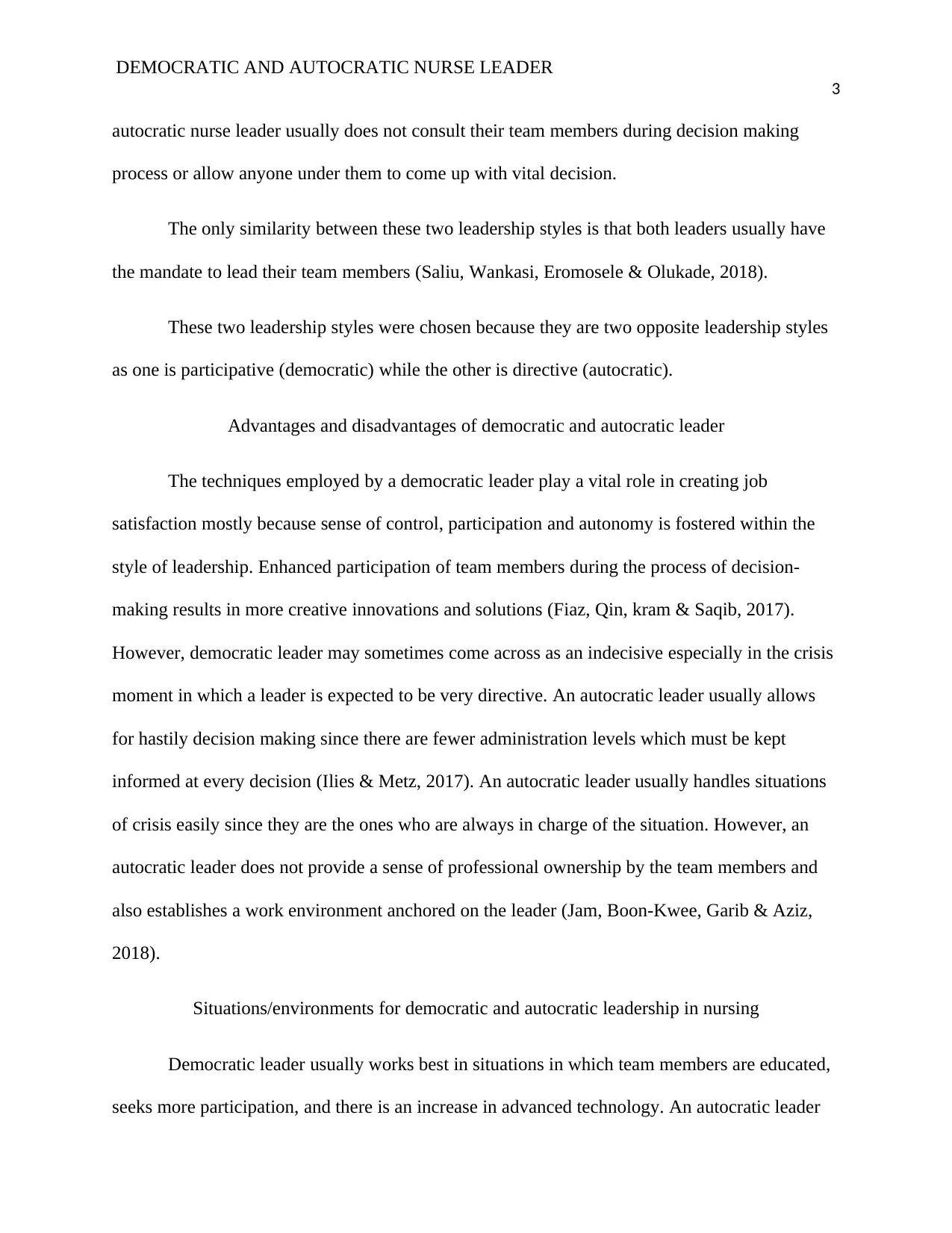
DEMOCRATIC AND AUTOCRATIC NURSE LEADER
3
autocratic nurse leader usually does not consult their team members during decision making
process or allow anyone under them to come up with vital decision.
The only similarity between these two leadership styles is that both leaders usually have
the mandate to lead their team members (Saliu, Wankasi, Eromosele & Olukade, 2018).
These two leadership styles were chosen because they are two opposite leadership styles
as one is participative (democratic) while the other is directive (autocratic).
Advantages and disadvantages of democratic and autocratic leader
The techniques employed by a democratic leader play a vital role in creating job
satisfaction mostly because sense of control, participation and autonomy is fostered within the
style of leadership. Enhanced participation of team members during the process of decision-
making results in more creative innovations and solutions (Fiaz, Qin, kram & Saqib, 2017).
However, democratic leader may sometimes come across as an indecisive especially in the crisis
moment in which a leader is expected to be very directive. An autocratic leader usually allows
for hastily decision making since there are fewer administration levels which must be kept
informed at every decision (Ilies & Metz, 2017). An autocratic leader usually handles situations
of crisis easily since they are the ones who are always in charge of the situation. However, an
autocratic leader does not provide a sense of professional ownership by the team members and
also establishes a work environment anchored on the leader (Jam, Boon-Kwee, Garib & Aziz,
2018).
Situations/environments for democratic and autocratic leadership in nursing
Democratic leader usually works best in situations in which team members are educated,
seeks more participation, and there is an increase in advanced technology. An autocratic leader
3
autocratic nurse leader usually does not consult their team members during decision making
process or allow anyone under them to come up with vital decision.
The only similarity between these two leadership styles is that both leaders usually have
the mandate to lead their team members (Saliu, Wankasi, Eromosele & Olukade, 2018).
These two leadership styles were chosen because they are two opposite leadership styles
as one is participative (democratic) while the other is directive (autocratic).
Advantages and disadvantages of democratic and autocratic leader
The techniques employed by a democratic leader play a vital role in creating job
satisfaction mostly because sense of control, participation and autonomy is fostered within the
style of leadership. Enhanced participation of team members during the process of decision-
making results in more creative innovations and solutions (Fiaz, Qin, kram & Saqib, 2017).
However, democratic leader may sometimes come across as an indecisive especially in the crisis
moment in which a leader is expected to be very directive. An autocratic leader usually allows
for hastily decision making since there are fewer administration levels which must be kept
informed at every decision (Ilies & Metz, 2017). An autocratic leader usually handles situations
of crisis easily since they are the ones who are always in charge of the situation. However, an
autocratic leader does not provide a sense of professional ownership by the team members and
also establishes a work environment anchored on the leader (Jam, Boon-Kwee, Garib & Aziz,
2018).
Situations/environments for democratic and autocratic leadership in nursing
Democratic leader usually works best in situations in which team members are educated,
seeks more participation, and there is an increase in advanced technology. An autocratic leader
⊘ This is a preview!⊘
Do you want full access?
Subscribe today to unlock all pages.

Trusted by 1+ million students worldwide
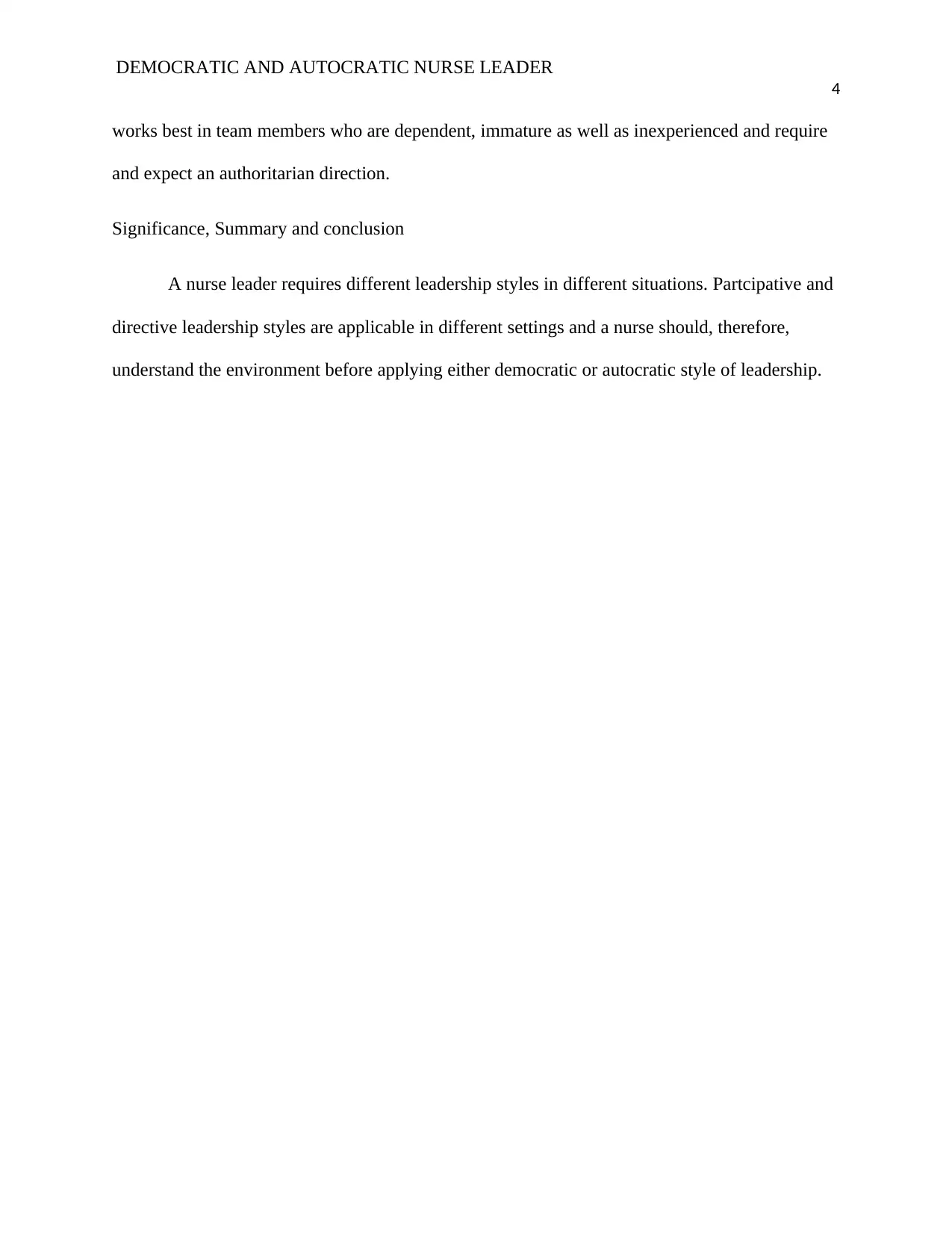
DEMOCRATIC AND AUTOCRATIC NURSE LEADER
4
works best in team members who are dependent, immature as well as inexperienced and require
and expect an authoritarian direction.
Significance, Summary and conclusion
A nurse leader requires different leadership styles in different situations. Partcipative and
directive leadership styles are applicable in different settings and a nurse should, therefore,
understand the environment before applying either democratic or autocratic style of leadership.
4
works best in team members who are dependent, immature as well as inexperienced and require
and expect an authoritarian direction.
Significance, Summary and conclusion
A nurse leader requires different leadership styles in different situations. Partcipative and
directive leadership styles are applicable in different settings and a nurse should, therefore,
understand the environment before applying either democratic or autocratic style of leadership.
Paraphrase This Document
Need a fresh take? Get an instant paraphrase of this document with our AI Paraphraser
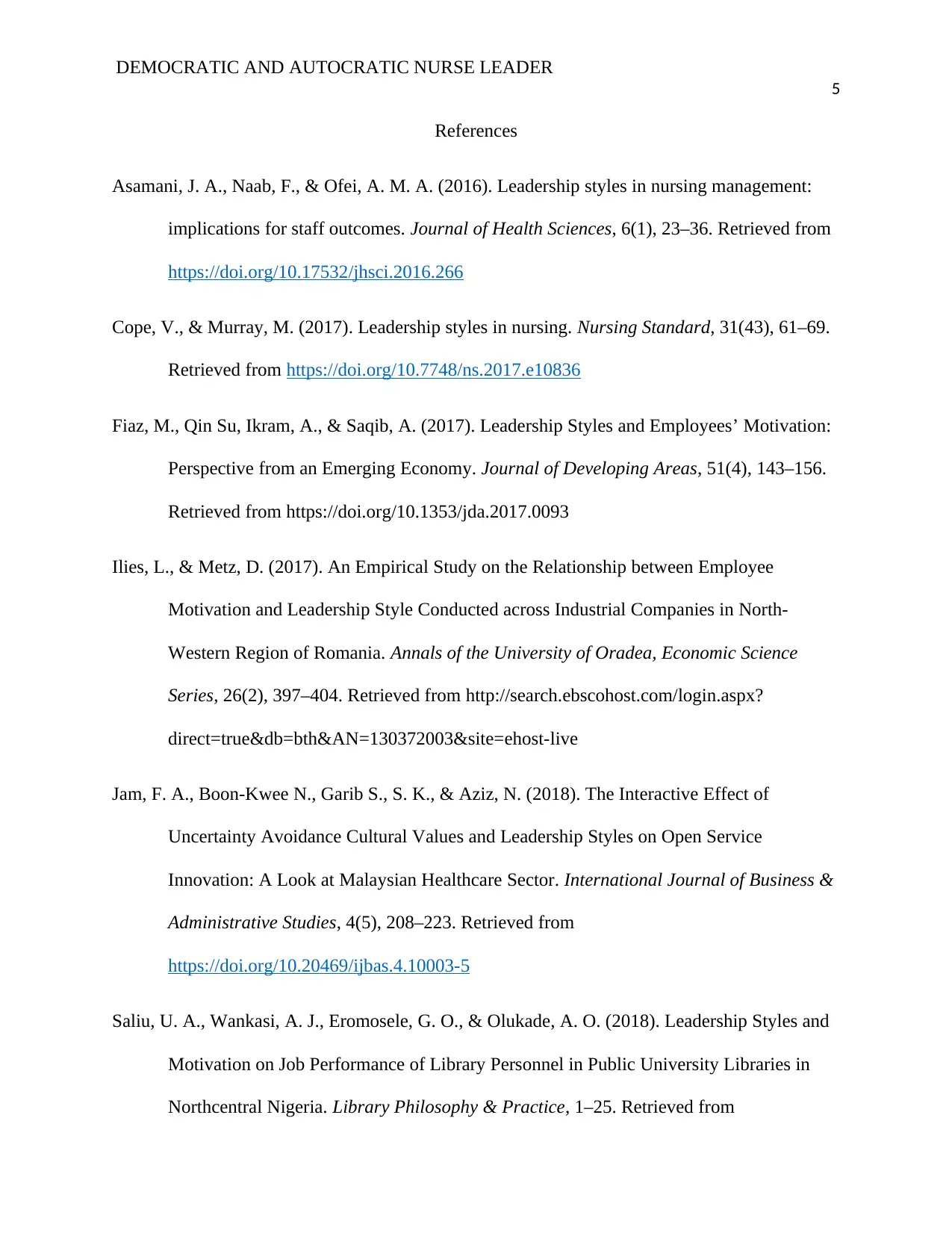
DEMOCRATIC AND AUTOCRATIC NURSE LEADER
5
References
Asamani, J. A., Naab, F., & Ofei, A. M. A. (2016). Leadership styles in nursing management:
implications for staff outcomes. Journal of Health Sciences, 6(1), 23–36. Retrieved from
https://doi.org/10.17532/jhsci.2016.266
Cope, V., & Murray, M. (2017). Leadership styles in nursing. Nursing Standard, 31(43), 61–69.
Retrieved from https://doi.org/10.7748/ns.2017.e10836
Fiaz, M., Qin Su, Ikram, A., & Saqib, A. (2017). Leadership Styles and Employees’ Motivation:
Perspective from an Emerging Economy. Journal of Developing Areas, 51(4), 143–156.
Retrieved from https://doi.org/10.1353/jda.2017.0093
Ilies, L., & Metz, D. (2017). An Empirical Study on the Relationship between Employee
Motivation and Leadership Style Conducted across Industrial Companies in North-
Western Region of Romania. Annals of the University of Oradea, Economic Science
Series, 26(2), 397–404. Retrieved from http://search.ebscohost.com/login.aspx?
direct=true&db=bth&AN=130372003&site=ehost-live
Jam, F. A., Boon-Kwee N., Garib S., S. K., & Aziz, N. (2018). The Interactive Effect of
Uncertainty Avoidance Cultural Values and Leadership Styles on Open Service
Innovation: A Look at Malaysian Healthcare Sector. International Journal of Business &
Administrative Studies, 4(5), 208–223. Retrieved from
https://doi.org/10.20469/ijbas.4.10003-5
Saliu, U. A., Wankasi, A. J., Eromosele, G. O., & Olukade, A. O. (2018). Leadership Styles and
Motivation on Job Performance of Library Personnel in Public University Libraries in
Northcentral Nigeria. Library Philosophy & Practice, 1–25. Retrieved from
5
References
Asamani, J. A., Naab, F., & Ofei, A. M. A. (2016). Leadership styles in nursing management:
implications for staff outcomes. Journal of Health Sciences, 6(1), 23–36. Retrieved from
https://doi.org/10.17532/jhsci.2016.266
Cope, V., & Murray, M. (2017). Leadership styles in nursing. Nursing Standard, 31(43), 61–69.
Retrieved from https://doi.org/10.7748/ns.2017.e10836
Fiaz, M., Qin Su, Ikram, A., & Saqib, A. (2017). Leadership Styles and Employees’ Motivation:
Perspective from an Emerging Economy. Journal of Developing Areas, 51(4), 143–156.
Retrieved from https://doi.org/10.1353/jda.2017.0093
Ilies, L., & Metz, D. (2017). An Empirical Study on the Relationship between Employee
Motivation and Leadership Style Conducted across Industrial Companies in North-
Western Region of Romania. Annals of the University of Oradea, Economic Science
Series, 26(2), 397–404. Retrieved from http://search.ebscohost.com/login.aspx?
direct=true&db=bth&AN=130372003&site=ehost-live
Jam, F. A., Boon-Kwee N., Garib S., S. K., & Aziz, N. (2018). The Interactive Effect of
Uncertainty Avoidance Cultural Values and Leadership Styles on Open Service
Innovation: A Look at Malaysian Healthcare Sector. International Journal of Business &
Administrative Studies, 4(5), 208–223. Retrieved from
https://doi.org/10.20469/ijbas.4.10003-5
Saliu, U. A., Wankasi, A. J., Eromosele, G. O., & Olukade, A. O. (2018). Leadership Styles and
Motivation on Job Performance of Library Personnel in Public University Libraries in
Northcentral Nigeria. Library Philosophy & Practice, 1–25. Retrieved from

DEMOCRATIC AND AUTOCRATIC NURSE LEADER
6
http://search.ebscohost.com/login.aspx?
direct=true&db=lxh&AN=133865497&site=ehost-live
6
http://search.ebscohost.com/login.aspx?
direct=true&db=lxh&AN=133865497&site=ehost-live
⊘ This is a preview!⊘
Do you want full access?
Subscribe today to unlock all pages.

Trusted by 1+ million students worldwide
1 out of 6
Related Documents
Your All-in-One AI-Powered Toolkit for Academic Success.
+13062052269
info@desklib.com
Available 24*7 on WhatsApp / Email
![[object Object]](/_next/static/media/star-bottom.7253800d.svg)
Unlock your academic potential
Copyright © 2020–2025 A2Z Services. All Rights Reserved. Developed and managed by ZUCOL.





